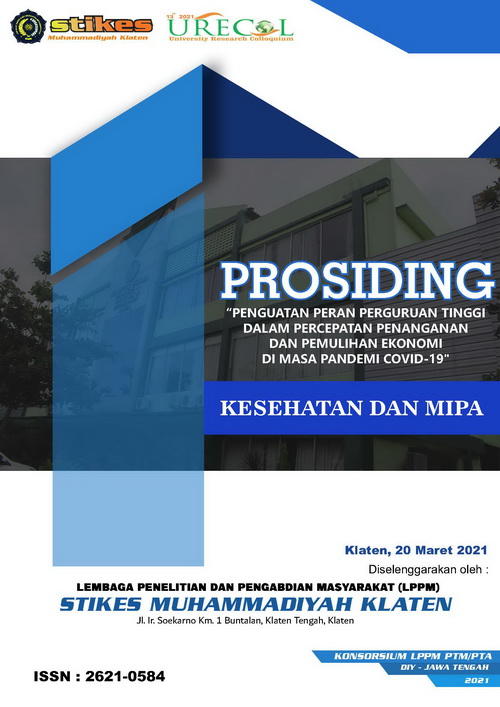FAKTOR YANG MEMPENGARUHI KEJANG DEMAM PADA ANAK DI RUANG RAWAT INAP RSUD PRAMBANAN
Keywords:
Febrile seizures, ChildrenAbstract
Fever seizures in children caused by an increase in body temperature of more than 380C. In Indonesia, febrile seizures occur in 2-4% of children aged 6 months-5 years. Fever seizures in children can be influenced by various factors including age, gender, high temperature, family history of seizures, infectious diseases. This study aims to determine the relationship between the level of family anxiety during the Covid 19 pandemic regarding treatment and the incidence of withdrawal from schizophrenic patients at Dr. RM. Soedjarwadi, Central Java Province. This type of research is an observational analytic, case control study design with a retrospective approach. The sampling technique used total sampling. The number of children with febrile seizures was 44 respondents and 44 respondents did not have fever seizures so that the total sample was 88 respondents. Retrieval of data using medical records. Univariate statistical test using frequency distribution, bivariate using chi square test and multivariate using multiple logistic regression test. The results obtained in the case group, most of the respondents were 12-36 months (61.4%), male (65.9%), had a body temperature> 380C (59.1%), no history of febrile seizures. in the family (72.7%) and there is an infectious disease (97.7%), while the control group is mostly respondents aged 12-36 months (65.9%), male (54.5%), body ?380C (65.9%), there was no family history of febrile seizures (90.9%) and there was an infectious disease (86.4%). Factors associated with the incidence of febrile seizures were body temperature (p value 0.019), family history of seizures (p value 0.027) and childhood infectious disease (p value 0.049) while age (p value 0.448) and gender (p value 0.276) were not. associated with the incidence of febrile seizures. The conclusion of this study is that the most influencing factor on febrile seizures is a family history of seizures with a p value of 0.034 (p <0.05), children who have a history of family febrile seizures are at risk of 3.902 times experiencing febrile seizures.
References
Suatu Pendekatan Praktik. Jakarta:
Rineka Cipta.
Camfield, P. and Camfield, C. (2015)
‘Incidence, prevalence and aetiology of
seizures and epilepsy in children’,
Epileptic Disorders. doi:
10.1684/epd.2015.0736.
Dahlan, S. (2015) Statistik untuk
Kedokteran dan Kesehatan. Jakarta:
Epidemiologi Indonesia.
Deliana, M. (2016) ‘Tata Laksana Kejang
Demam pada Anak’, Sari Pediatri, 4(2),
p. 59. doi: 10.14238/sp4.2.2002.59-62.
Dharma, K. K. (2013) Metodologi
Penelitian Keperawatan. Jakarta: Trans
Info Media.
Fuadi (2010) ‘Faktor Risiko Bangkitan
Kejang Demam pada Anak’, Sari
Pediatri, 12(3), p. 142.
Lubis, S. P. S. (2019) ‘Gambaran
Pengetahuan Ibu Tentang Perawatan
Kejang Demam Pada Anak di Ruangan
Anak Rsup H. Adam Malik Medan Tahun
2019’, Jurusan Keperawatan Poltekes
Kemenkes Medan, Munawaroh, pp. 1–13.
Ngastiyah (2014) Perawatan Anak Sakit. Jakarta: Penerbit Buku Kedokteran EGC.
Notoatmodjo, S. (2018) Metodologi
Penelitian Kesehatan. Jakarta: Rineka
Cipta.
Nurafif, A. H. and Kusuma, H. (2017)
Aplikasi Asuhan Keperawatan
Berdasarkan Diagnosa Medis dan
NANDA NIC-NOC. Yogyakarta: Media
Action Publishing.
Putri, D. and Kusbaryanto (2012)
‘Perbedaan Hubungan antara Ibu Bekerja
dan Ibu Rumah Tangga terhadap Tumbuh
Kembang Anak Usia 2-5 Tahun’, Mutiara
Medika, 12(3), pp. 143–149.
Rasyid, Z., Astuti, D. K. and Purba, C. V.
G. (2019) ‘Determinan Kejadian Kejang
Demam pada Balita di Rumah Sakit Ibu
dan Anak Budhi Mulia Pekanbaru’, Jurnal
Epidemiologi Kesehatan Indonesia, 3(1),
pp. 1–6. doi: 10.7454/epidkes.v3i1.2108.
Saputro, M. A. (2017) ‘Implementasi
Sistem Monitoring Detak Jantung dan
Suhu Tubuh Manusia Secara Wireless’,
Pengembangan Teknologi Informasi Dan
Ilmu Komputer, 1(2), pp. 148–156.
Soediono, B. (2014) ‘INFO DATIN
KEMENKES RI Kondisi Pencapaian
Program Kesehatan Anak Indonesia’,
Journal of Chemical Information and
Modeling, 53, p. 160.
Sugiyono (2016) Metode Penelitian
Kuantitatif, Kualitatif, dan R & D.
Bandung: Alfabeta.
Windawati, W. and Alfiyanti, D. (2020)
‘Penurunan Hipertermia Pada Pasien
Kejang Demam Menggunakan Kompres
Hangat’, Ners Muda, 1(1), p. 59. doi:
10.26714/nm.v1i1.5499.
Downloads
Published
How to Cite
Issue
Section
License
Copyright (c) 2021 S Supardi, Fitri Suciana, Ambar Winarti, Neti Amayawati

This work is licensed under a Creative Commons Attribution-NonCommercial 4.0 International License.



